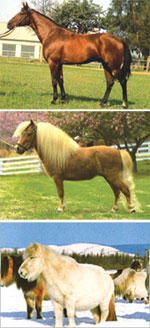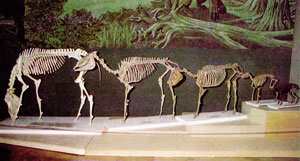Chapter 6:
The Imaginary Evolution of Birds and Mammals
Special Lungs for Birds | |
| The anatomy of birds is very different from that of reptiles, their supposed ancestors. Bird lungs function in a totally different way from those of land-dwelling animals. Land-dwelling animals breathe in and out from the same air vessel. In birds, while the air enters into the lung from the front, it goes out from the back. Allah created this distinct system specially for birds, which need great amounts of oxygen during flight. It is impossible for such a structure to evolve from the reptile lung. | |
 | |
| 1. Reptile Lung, | 2.Avian Lung |
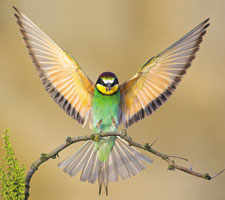 | 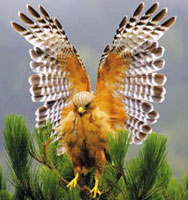 |
According to the theory of evolution, life originated and evolved in the sea and then was transported onto land by amphibians. This evolutionary scenario also suggests that amphibians evolved into reptiles, creatures living only on land. This scenario is again implausible, due to the enormous structural differences between these two classes of animals.
For instance, the amphibian egg is created for developing in water whereas the amniotic egg is created for developing on land. A "step by step" evolution of an amphibian is out of the question, because without a perfect and fully-formed egg, it is not possible for a species to survive. Moreover, as usual, there is no evidence of transitional forms that were supposed to link amphibians with reptiles. Evolutionist paleontologist and an authority on vertebrate paleontology, Robert L. Carroll has to accept that "the early reptiles were very different from amphibians and that their ancestors could not be found yet."45
Yet the hopelessly doomed scenarios of the evolutionists are not over yet. There still remains the problem of making these creatures fly! Since evolutionists believe that birds must somehow have been evolved, they assert that they were transformed from reptiles.
owever, none of the distinct mechanisms of birds, which have a completely different structure from land-dwelling animals, can be explained by gradual evolution. First of all, the wings, which are the exceptional traits of birds, are a great impasse for the evolutionists. One of the Turkish evolutionists, Engin Korur, confesses the impossibility of the evolution of wings:
The common trait of the eyes and the wings is that they can only function if they are fully developed. In other words, a halfway-developed eye cannot see; a bird with half-formed wings cannot fly. How these organs came into being has remained one of the mysteries of nature that needs to be enlightened.46
The question of how the perfect structure of wings came into being as a result of consecutive haphazard mutations remains completely unanswered. There is no way to explain how the front arms of a reptile could have changed into perfectly functioning wings as a result of a distortion in its genes (mutation).
Moreover, just having wings is not sufficient for a land organism to fly. Land-dwelling organisms are devoid of many other structural mechanisms that birds use for flying. For example, the bones of birds are much lighter than those of land-dwelling organisms. Their lungs function in a very different way. They have a different muscular and skeletal system and a very specialised heart-circulatory system. These features are pre-requisites of flying needed at least as much as wings. All these mechanisms had to exist at the same time and altogether; they could not have formed gradually by being "accumulated". This is why the theory asserting that land organisms evolved into aerial organisms is completely fallacious.
All of these bring another question to the mind: even if we suppose this impossible story to be true, then why are the evolutionists unable to find any "half-winged" or "single-winged" fossils to back up their story?
Another Alleged Transitional Form: Archæopteryx
 |
| According to evolutionists, some small dinosaurs, such as Velociraptors or Dromeosaurs, evolved by acquiring wings and then starting to fly. Thus, Archæopteryx is assumed to be a transitional form that branched off from its dinosaur ancestors and started to fly for the first time. This imaginary tale appears in almost all evolutionist publications. |
Evolutionists pronounce the name of one single creature in response. This is the fossil of a bird called Archæopteryx, one of the most widely-known so-called transitional forms among the very few that evolutionists still defend.
rchæopteryx, the so-called ancestor of present-day birds according to evolutionists, lived approximately 150 million years ago. The theory holds that some small dinosaurs, such as Velociraptors or Dromeosaurs, evolved by acquiring wings and then starting to fly. Thus, Archæopteryx is assumed to be a transitional form that branched off from its dinosaur ancestors and started to fly for the first time.
However, the latest studies of Archæopteryx fossils indicate that this creature is absolutely not a transitional form, but an extinct species of bird, having some insignificant differences from present-day birds.
The thesis that Archæopteryx was a "half-bird" that could not fly perfectly was popular among evolutionist circles until not long ago. The absence of a sternum (breastbone) in this creature was held up as the most important evidence that this bird could not fly properly. (The sternum is a bone found under the thorax to which the muscles required for flight are attached. In our day, this breastbone is observed in all flying and non-flying birds, and even in bats, a flying mammal which belongs to a very different family.)
However, the seventh Archæopteryx fossil, which was found in 1992, caused great astonishment among evolutionists. The reason was that in this recently discovered fossil, the breastbone that was long assumed by evolutionists to be missing was discovered to have existed after all. This fossil was described in Nature magazine as follows:
The recently discovered seventh specimen of the Archæopteryx preserves a partial, rectangular sternum, long suspected but never previously documented. This attests to its strong flight muscles.47
This discovery invalidated the mainstay of the claims that Archæopteryx was a half-bird that could not fly properly.
Moreover, the structure of the bird's feathers became one of the most important pieces of evidence confirming that Archæopteryx was a flying bird in the real sense. The asymmetric feather structure of Archæopteryx is indistinguishable from that of birds living today, and indicates that it could fly perfectly well. As the eminent paleontologist Carl O. Dunbar states, "because of its feathers [Archæopteryx is] distinctly to be classed as a bird." 48
Another fact that was revealed by the structure of Archæopteryx's feathers was its warm-blooded metabolism. As was discussed above, reptiles and dinosaurs are cold-blooded animals whose body heat fluctuates with the temperature of their environment, rather than being homeostatically regulated. A very important function of the feathers on birds is the maintenance of a constant body temperature. The fact that Archæopteryx had feathers showed that it was a real, warm-blooded bird that needed to regulate its body heat, in contrast to dinosaurs.
Bird Feathers: The Structure that Evolution Fails to Explain |
| The theory of evolution, which claims that birds evolved from reptiles, is unable to explain the huge differences between these two different living classes. In terms of such features as their skeleton structure, lung systems, and warm-blooded metabolism, birds are very different from reptiles. Another trait that poses an insurmountable gap between birds and reptiles is the feathers of birds which have a form entirely peculiar to them. The bodies of reptiles are covered with scales, whereas the bodies of birds are covered with feathers. Since evolutionists consider reptiles the ancestor of birds, they are obliged to claim that bird feathers have evolved from reptile scales. However, there is no similarity between scales and feathers. A professor of physiology and neurobiology from the University of Connecticut, A.H. Brush, accepts this reality although he is an evolutionist: "Every feature from gene structure and organization, to development, morphogenesis and tissue organization is different (in feathers and scales)."1 Moreover, Prof. Brush examines the protein structure of bird feathers and argues that it is "unique among vertebrates".2 There is no fossil evidence to prove that bird feathers evolved from reptile scales. On the contrary, "feathers appear suddenly in the fossil record, as an'undeniably unique' character distinguishing birds" as Prof. Brush states.3 Besides, in reptiles, no epidermal structure has yet been detected that provides an origin for bird feathers.4 In 1996, paleontologists made abuzz about fossils of a so-called feathered dinosaur, called Sinosauropteryx. However, in 1997, it was revealed that these fossils had nothing to do with birds and that they were not avian feathers.5  On the other hand, when we examine bird feathers closely, we come across a very complex structure that cannot be explained by any evolutionary process. The famous ornithologist Alan Feduccia states that "every feature of them has aerodynamic functions. They are extremely light, have the ability to lift up which increases in lower speeds, and may return to their previous position very easily". Then he continues, "I cannot really understand how an organ perfectly designed for flight may have emerged for another need at the beginning".6 The structure of feathers also compelled Charles Darwin to ponder them. Moreover, the perfect aesthetics of the peafowl's feathers had made him "sick" (his own words). In a letter he wrote to Asa Gray on April 3, 1860, he said "I remember well the time when the thought of the eye made me cold all over, but I have got over this stage of complaint..."And then continued: "...and now trifling particulars of structure often make me very uncomfortable. The sight of a feather in a peacock's tail, whenever I gaze at it, makes me sick!" 7 |
|
1. A. H. Brush, "On the Origin of Feathers", Journal of Evolutionary Biology, Vol. 9, 1996, s. 132. 2. A. H. Brush, "On the Origin of Feathers", s. 131. 3. A. H. Brush, "On the Origin of Feathers", s. 133. 4. A. H. Brush, "On the Origin of Feathers", s. 131. 5. "Plucking the Feathered Dinosaur", Science, Cilt 278, 14 Kasım 1997, s. 1229. 6. Douglas Palmer, "Learning to Fly", (Review of The Origin of and Evolution of Birds by Alan Feduccia, Yale University Press, 1996), New Scientist, Cilt 153, 1 Mart 1997, s. 44. 7. Norman Macbeth, Darwin Retried: An Appeal to Reason. Boston: Gambit, 1971, s. 101. |
Speculations of Evolutionists: The Teeth and Claws of Archæopteryx
Two important points evolutionist biologists rely on when claiming Archæopteryx was a transitional form, are the claws on its wings and its teeth.
Archæopteryx exhibits the features of a full-fledged bird: | |
 | 1.Its feathers show that it was a warm-blooded creature able to fly. 2.Its bones are hollow, like those of birds living today. 3.Its teeth represent no evidence that it evolved from reptiles. Many toothed bird species lived in the past. 4.There are bird species living today that possess similar claws on their wings. 5.The breastbone was observed in the seventh Archæopteryx fossil found recently. The presence of this bone shows that just like present-day birds, it possessed powerful flight muscles. |
It is true that Archæopteryx had claws on its wings and teeth in its mouth, but these traits do not imply that the creature bore any kind of relationship to reptiles. Besides, two bird species living today, Taouraco and Hoatzin, have claws which allow them to hold onto branches. These creatures are fully birds, with no reptilian characteristics. That is why it is completely groundless to assert that Archæopteryx is a transitional form just because of the claws on its wings.
Neither do the teeth in Archæopteryx's beak imply that it is a transitional form. Evolutionists make a purposeful trickery by saying that these teeth are reptile characteristics, since teeth are not a typical feature of reptiles. Today, some reptiles have teeth while others do not. Moreover, Archæopteryx is not the only bird species to possess teeth. It is true that there are no toothed birds in existence today, but when we look at the fossil record, we see that both during the time of Archæopteryx and afterwards, and even until fairly recently, a distinct bird genus existed that could be categorised as "birds with teeth".
The most important point is that the tooth structure of Archæopteryx and other birds with teeth is totally different from that of their alleged ancestors, the dinosaurs. The well-known ornithologists L. D. Martin, J. D. Steward, and K. N. Whetstone observed that Archæopteryx and other similar birds have teeth with flat-topped surfaces and large roots. Yet the teeth of theropod dinosaurs, the alleged ancestors of these birds, are protuberant like saws and have narrow roots.49
These researchers also compared the wrist bones of Archæopteryx and their alleged ancestors, the dinosaurs, and observed no similarity between them.50
Studies by anatomists like S. Tarsitano, M. K. Hecht, and A.D. Walker have revealed that some of the similarities that John Ostrom and other have seen between Archæopteryx and dinosaurs were in reality misinterpretations.51
All these findings indicate that Archæopteryx was not a transitional link but only a bird that fell into a category that can be called "toothed birds"
Archæopteryx and Other Bird Fossils
While evolutionists have for decades been proclaiming Archæopteryx to be the greatest evidence for their scenario concerning the evolution of birds, some recently-found fossils invalidate that scenario in other respects.
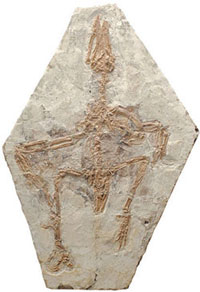 |
| The bird named Confuciusornis is the same age as Archæopteryx. |
Lianhai Hou and Zhonghe Zhou, two paleontologists at the Chinese Institute of Vertebrate Paleontology, discovered a new bird fossil in 1995, and named it Confuciusornis. This fossil is almost the same age as Archæopteryx (around 140 million years), but has no teeth in its mouth. In addition, its beak and feathers shared the same features as today's birds. Confuciusornis has the same skeletal structure as present-day birds, but also has claws on its wings, just like Archæopteryx. Another structure peculiar to birds called the "pygostyle", which supports the tail feathers, was also found in Confuciusornis. In short, this fossil-which is the same age as Archæopteryx, which was previously thought to be the earliest bird and was accepted as a semi-reptile-looks very much like a bird living today. This fact has invalidated all the evolutionist theses claiming Archæopteryx to be the primitive ancestor of all birds.52
Another fossil unearthed in China, caused even greater confusion. In November 1996, the existence of a 130-million-year-old bird named Liaoningorniswas announced in Science by L. Hou, L. D. Martin, and Alan Feduccia. Liaoningornis had a breastbone to which the muscles for flight were attached, just as in today’s birds. This bird was indistinguishable from present-day birds also in other respects, too. The only difference was the teeth in its mouth. This showed that birds with teeth did not possess the primitive structure alleged by evolutionists.53
This was stated in an article in Discover "Whence came the birds? This fossil suggests that it was not from dinosaur stock".54
Another fossil that refuted the evolutionist claims regarding Archæopteryx was Eoalulavis. The wing structure of Eoalulavis, which was said to be some 25 to 30 million years younger than Archæopteryx, was also observed in today’s slow-flying birds. This proved that 120 million years ago, there were birds indistinguishable from birds of today in many respects flying in the skies.55
These facts once more indicate for certain that neither Archæopteryx nor other ancient birds similar to it were transitional forms. The fossils do not indicate that different bird species evolved from each other. On the contrary, the fossil record proves that today's birds and some archaic birds such as Archæopteryx actually lived together at the same time. Some of these bird species, such as Archæopteryx and Confuciusornis, have become extinct, and only some of the species that once existed have been able to survive down to the present day.
In brief, several features of Archæopteryx indicate that this creature was not a transitional form. The overall anatomy of Archæopteryx imply stasis, not evolution. Paleontologist Robert Carroll has to admit that:
The geometry of the flight feathers of Archæopteryx is identical with that of modern flying birds, whereas nonflying birds have symmetrical feathers. The way in which the feathers are arranged on the wing also falls within the range of modern birds… According to Van Tyne and Berger, the relative size and shape of the wing of Archæopteryx are similar to that of birds that move through restricted openings in vegetation, such as gallinaceous birds, doves, woodcocks, woodpeckers, and most passerine birds… The flight feathers have been in stasis for at least 150 million years…56
On the other hand, the "temporal paradox" is one of the facts that deal the fatal blow to the evolutionist allegations about Archæopteryx. In his book Icons of Evolution, Jonathan Wells remarks that Archæopteryx has been turned into an "icon" of the theory of evolution, whereas evidence clearly shows that this creature is not the primitive ancestor of birds. According to Wells, one of the indications of this is that theropod dinosaurs—the alleged ancestors of Archæopteryx—are actually younger than Archæopteryx:
Two-legged reptiles that ran along the ground, and had other features one might expect in an ancestor of Archæopteryx, appear later.57
The Imaginary Bird-Dinosaur Link
 |
| Prof. Alan Feduccia |
The claim of evolutionists trying to present Archæopteryx as a transitional form is that birds have evolved from dinosaurs. However, one of the most famous ornithologists in the world, Alan Feduccia from the University of North Carolina, opposes the theory that birds are related to dinosaurs, despite the fact that he is an evolutionist himself. Feduccia has this to say regarding the thesis of reptile-bird evolution:
Well, I've studied bird skulls for 25 years and I don't see any similarities whatsoever. I just don't see it... The theropod origins of birds, in my opinion, will be the greatest embarrassment of paleontology of the 20th century.58
Larry Martin, a specialist on earlier birds from the University of Kansas, also opposes the theory that birds are descended from dinosaurs. Discussing the contradiction that evolution falls into on the subject, he states:
To tell you the truth, if I had to support the dinosaur origin of birds with those characters, I'd be embarrassed every time I had to get up and talk about it.59
To sum up, the scenario of the "evolution of birds" erected solely on the basis of Archæopteryx, is nothing more than a product of the prejudices and wishful thinking of evolutionists.
What is the Origin of Flies? |
| Claiming that dinosaurs transformed into birds, evolutionists support their assertion by saying that some dinosaurs who flapped their front legs to hunt flies "took wing and flew" as seen in the picture. 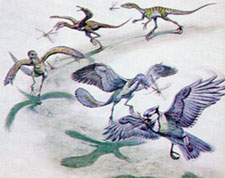  Having no scientific basis whatsoever and being nothing but a figment of the imagination, this theory also entails a very simple logical contradiction: the example given by evolutionists to explain the origin of flying, that is, the fly, already has a perfect ability to fly. Whereas a human cannot open and close his eyes 10 times a second, an average fly flutters its wings 500 times a second. Moreover, it moves both its wings simultaneously. The slightest dissonance in the vibration of wings would cause the fly lose its balance but this never happens. Evolutionists should first come up with an explanation as to how the fly acquired this perfect ability to fly. Instead, they fabricate imaginary scenarios about how much more clumsy creatures like reptiles came to fly. Even the perfect creation of the housefly invalidates the claim of evolution. English biologist Robin Wootton wrote in an article titled "The Mechanical Design of Fly Wings": The better we understand the functioning of insect wings, the more subtle and beautiful their designs appear. Structures are traditionally designed to deform as little as possible; mechanisms are designed to move component parts in predictable ways. Insect wings combine both in one, using components with a wide range of elastic properties, elegantly assembled to allow appropriate deformations in response to appropriate forces and to make the best possible use of the air. They have few if any technological parallels-yet.1 On the other hand, there is not a single fossil that can be evidence for the imaginary evolution of flies. This is what the distinguished French zoologist Pierre Grassé meant when he said "We are in the dark concerning the origin of insects." 2 |
|
1 J. Robin Wootton, "The Mechanical Design of Insect Wings", Scientific American, Cilt 263, Kasım 1990, s. 120. 2 Pierre-P Grassé, Evolution of Living Organisms, New York: Academic Press, 1977, s. 30 |
The Origin of Mammals
As we have stated before, the theory of evolution proposes that some imaginary creatures that came out of the sea turned into reptiles, and that birds evolved from reptiles. According to the same scenario, reptiles are the ancestors not only of birds but also of mammals. However, there are great differences between these two classes. Mammals are warm-blooded animals (this means they can generate their own heat and maintain it at a steady level), they give live birth, they suckle their young, and their bodies are covered in fur or hair. Reptiles, on the other hand, are cold-blooded (i.e., they cannot generate heat, and their body temperature changes according to the external temperature), they lay eggs, they do not suckle their young, and their bodies are covered in scales.
Bats | |
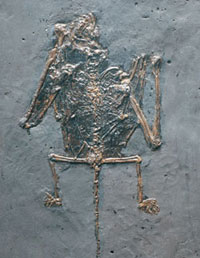 | Evolutionists propose that all mammal species evolved from a common ancestor. However, there are great differences between various mammal species such as bears, whales, mice, and bats. Each of these living beings possesses specific systems. For example, bats are created with a very sensitive sonar system that helps them find their way in darkness. These complex systems, which modern technology can only imitate, could not possibly have emerged as a result of chance coincidence. The fossil record also demonstrates that bats came into being in their present perfect state all of a sudden and that they have not undergone any "evolutionary process". A bat fossil aged 50 million years: no different from its present-day counterpart. (Science, vol. 154) |
One example of the structural barriers between reptiles and mammals is their jaw structure. Mammal jaws consist of only one mandibular bone containing the teeth. In reptiles, there are three little bones on both sides of the mandible. Another basic difference is that all mammals have three bones in their middle ear (hammer, anvil, and stirrup). Reptiles have but a single bone in the middle ear. Evolutionists claim that the reptile jaw and middle ear gradually evolved into the mammal jaw and ear. The question of how an ear with a single bone evolved into one with three bones, and how the sense of hearing kept on functioning in the meantime can never be explained. Not surprisingly, not one single fossil linking reptiles and mammals has been found.
This is why evolutionist science writer Roger Lewin was forced to say, "The transition to the first mammal, which probably happened in just one or, at most, two lineages, is still an enigma".60
George Gaylord Simpson, one of the most popular evolutionary authorities and a founder of the neo-Darwinist theory, makes the following comment regarding this perplexing difficulty for evolutionists:
The most puzzling event in the history of life on earth is the change from the Mesozoic, the Age of Reptiles, to the Age of Mammals. It is as if the curtain were rung down suddenly on the stage where all the leading roles were taken by reptiles, especially dinosaurs, in great numbers and bewildering variety, and rose again immediately to reveal the same setting but an entirely new cast, a cast in which the dinosaurs do not appear at all, other reptiles are supernumeraries, and all the leading parts are played by mammals of sorts barely hinted at in the preceding acts.61
Furthermore, when mammals suddenly made their appearance, they were already very different from each other. Such dissimilar animals as bats, horses, mice, and whales are all mammals, and they all emerged during the same geological period. Establishing an evolutionary relationship among them is impossible even by the broadest stretch of the imagination. The evolutionist zoologist R. Eric Lombard makes this point in an article that appeared in the leading journal Evolution:
Those searching for specific information useful in constructing phylogenies of mammalian taxa will be disappointed.62
All of these demonstrate that all living beings appeared on earth suddenly and fully formed, without any evolutionary process. This is concrete evidence of the fact that they were created. Evolutionists, however, try to interpret the fact that living species came into existence in a particular order as an indication of evolution. Yet the sequence by which living things emerged is the "order of creation", since it is not possible to speak of an evolutionary process. With a superior and flawless creation, oceans and then lands were filled with living things and finally man was created.
Contrary to the "ape man" story that is imposed on the masses with intense media propaganda, man also emerged on earth suddenly and fully formed.
Atın Evrimi Senaryosu | ||||
| Until recently, an imaginary sequence supposedly showing the evolution of the horse was advanced as the principal fossil evidence for the theory of evolution. Today, however, many evolutionists themselves frankly admit that the scenario of horse evolution is bankrupt. In 1980, a four-day symposium was held at the Field Museum of Natural History in Chicago, with 150 evolutionists in attendance, to discuss the problems with gradualistic evolutionary theory. In addressing the meeting, evolutionist Boyce Rensberger noted that the scenario of the evolution of the horse has no foundation in the fossil record, and that no evolutionary proccess has been observed that would account for the gradual evolution of horses:
The popularly told example of horse evolution, suggesting a gradual sequence of changes from four-toed fox-sized creatures living nearly 50 million years ago to today's much larger one-toed horse, has long been known to be wrong. Instead of gradual change, fossils of each intermediate species appear fully distinct, persist unchanged, and then become extinct. Transitional forms are unknown.1 Dr. Niles Eldredge said the following about the “evolution of the horse” diagrams: There have been an awful lot of stories, some more imaginative than others, about what the nature of that history [of life] really is. The most famous example, still on exhibit downstairs, is the exhibit on horse evolution prepared perhaps fifty years ago. That has been presented as the literal truth in textbook after textbook. Now I think that is lamentable, particularly when the people who propose those kinds of stories may themselves be aware of the speculative nature of some of that stuff.2 Then what is the basis for the scenario of the evolution of the horse? This scenario was formulated by means of the deceitful charts devised by the sequential arrangement of fossils of distinct species that lived at vastly different periods in India, South Africa, North America, and Europe solely in accordance with the rich power of evolutionists' imaginations. More than 20 charts of the evolution of the horse, which by the way are totally different from each other, have been proposed by various researchers. hus, it is obvious that evolutionists have reached no common agreement on these family trees. The only common feature in these arrangements is the belief that a dog-sized creature called "Eohippus", which lived in the Eocene Period 55 million years ago, was the ancestor of the horse (Equus). Yet Eohippus, portrayed as an equine ancestor that became extinct millions of years ago, is almost identical to the mammal known as “Hyrax” that still lives in Africa, but has not the slightest connection with horses.3 The invalidity of the claim regarding the evolution of the horse is becoming clearer every day with the discovery of new fossils. ohippus has been identified in strata containing some fossilized breeds of horse—Equus nevadensis and E. occidentalis—that are still alive today—Equus nevadensis.4 This shows that the present day horse lived at the same time as its supposed forebear, proving that the horse never underwent the process known as evolution. The evolutionist science writer Gordon R. Taylor explains this little-acknowledged truth in his book The Great Evolution Mystery:
But perhaps the most serious weakness of Darwinism is the failure of paleontologists to find convincing phylogenies or sequences of organisms demonstrating major evolutionary change... The horse is often cited as the only fully worked-out example. But the fact is that the line from Eohippus to Equus is very erratic. It is alleged to show a continual increase in size, but the truth is that some variants were smaller than Eohippus, not larger. Specimens from different sources can be brought together in a convincing-looking sequence, but there is no evidence that they were actually ranged in this order in time.5 All these facts are strong evidence that the charts of horse evolution, which are presented as one of the most solid pieces of evidence for Darwinism, are nothing but fantastic and implausible tales. | ||||
|
1 Boyce Rensberger, Houston Chronicle, November 5, 1980, p.15 2 Harper's Magazine, February, 1985, s. 60 3 Francis Hitching, The Neck of the Giraffe: Where Darwin Went Wrong, New York: Ticknor and Fields, 1982, ss. 30-31. 4 Francis Hitching, The Neck of the Giraffe, ss. 30-31. 5 Gordon Rattray Taylor, The Great Evolution Mystery, London: Sphere Books, 1984, s. 230 |
Footnotes
45. Robert L. Carroll, Vertebrate Paleontology and Evolution, New York: W. H. Freeman and Co., 1988, s. 198![]()
46. Engin Korur, "Gözlerin ve Kanatların Sırrı", Bilim ve Teknik, Sayı 203, Ekim 1984, s. 25![]()
47. Nature, cilt 382, 1 Ağustos 1996, s. 401![]()
48. Carl O. Dunbar, Historical Geology, New York: John Wiley and Sons, 1961, s. 310![]()
49. L. D. Martin, J. D. Stewart, K. N. Whetstone, The Auk, Cilt 98, 1980, s. 86![]()
50. L. D. Martin, J. D. Stewart, K. N. Whetstone, The Auk, Cilt 98, 1980, s. 86; L. D. Martin "Origins of Higher Groups of Tetrapods", Ithaca, New York: Comstock Publising Association, 1991, ss. 485, 540![]()
51. S. Tarsitano, M. K. Hecht, Zoological Journal of the Linnaean Society, Cilt 69, 1985, s. 178; A. D. Walker, Geological Magazine, Cilt 177, 1980, s. 595![]()
52. Pat Shipman, "Birds do it... Did Dinosaurs?", New Scientist, 1 Şubat 1997, s. 31![]()
53. "Old Bird", Discover, 21 Mart 1997![]()
54. "Old Bird", Discover, 21 Mart 1997![]()
55. Pat Shipman, "Birds Do It... Did Dinosaurs?", New Scientist, 1 Şubat 1997 s. 28![]()
56. S. J. Gould & N. Eldredge, Paleobiology, Vol 3, 1977, s. 147![]()
57. Jonathan Wells, Icons of Evolution, Regnery Publishing, 2000, s, 117![]()
58. Pat Shipman, "Birds Do It... Did Dinosaurs?", New Scientist, 1 Şubat 1997, s. 28![]()
59. Pat Shipman, "Birds Do It... Did Dinosaurs?", New Scientist, 1 Şubat 1997, s. 28![]()
60. Roger Lewin, "Bones of Mammals, Ancestors Fleshed Out", Science, cilt 212, 26 Haziran 1981, s. 1492![]()
61. George Gaylord Simpson, Life Before Man, New York: Time-Life Books, 1972, s. 42![]()
62. Eric Lombard, "Review of Evolutionary Principles of the Mammalian Middle Ear, Gerald Fleischer", Evolution, Cilt 33, Aralık 1979, s. 1230![]()
- Special Preface: The Real Ideological Root of Terrorism: Darwinism and Materialism
- Introduction: Why the Theory of Evolution?
- Foreword: A Great Miracle of Our Times: Belief in the Evolution Deceit
- Chapter 1: To Be Freed From Prejudice
- Chapter 2: A Brief History of the Theory
- Chapter 3: Imaginary Mechanisms of Evolution
- Chapter 4: The Fossil Record Refutes Evolution
- Chapter 5: Tale of Transition from Water to Land
- Chapter 6: The Imaginary Evolution of Birds and Mammals
- Chapter 7: Evolutionists' Biased and Deceptive Fossil Interpretations
- Chapter 8: Evolution Forgeries
- Chapter 9: The Scenario of Human Evolution
- Chapter 10: The Molecular Impasse of Evolution
- Chapter 11: Thermodynamics Falsifies Evolution
- Chapter 12: Order cannot Be Accounted for by Coincidence
- Chapter 13: Why Evolutionists' Claims are Invalid
- Chapter 14: The Theory of Evolution: A Materialistic Liability
- Chapter 15: Media: An Oxygen Tent for the Theory of Evolution
- Chapter 16: Conclusion: Evolution is a Deceit
- Chapter 17: The Fact of Creation
- Chapter 18: The Real Essence of Matter
- Chapter 19 : Relativity of Time and The Reality of Fate
- Chapter 20: SRF Conferences: Activities for Informing the Public About Evolution

